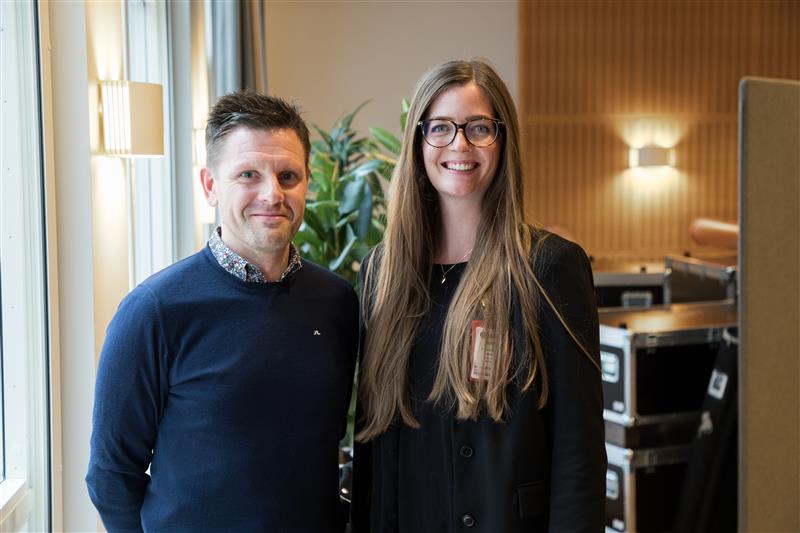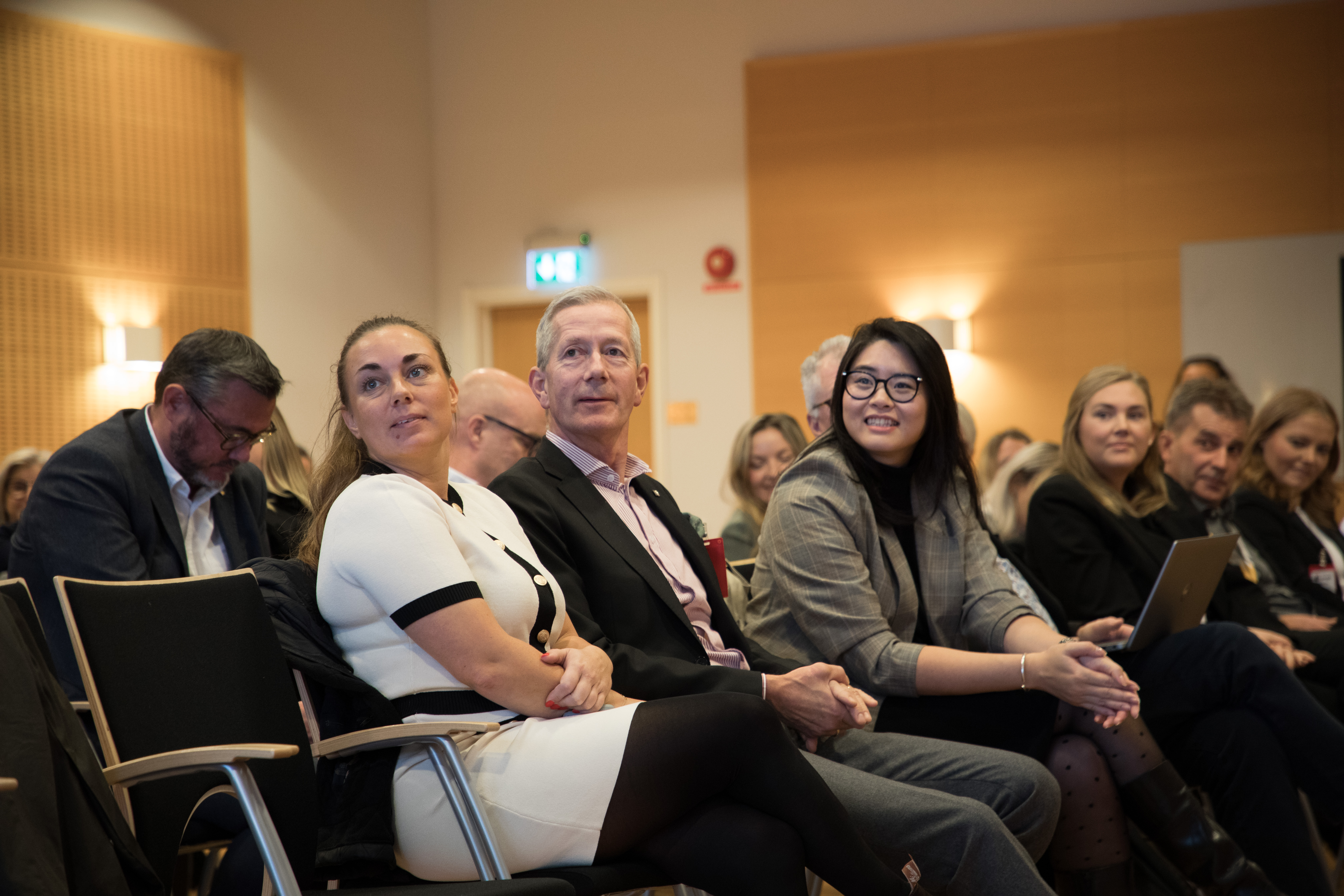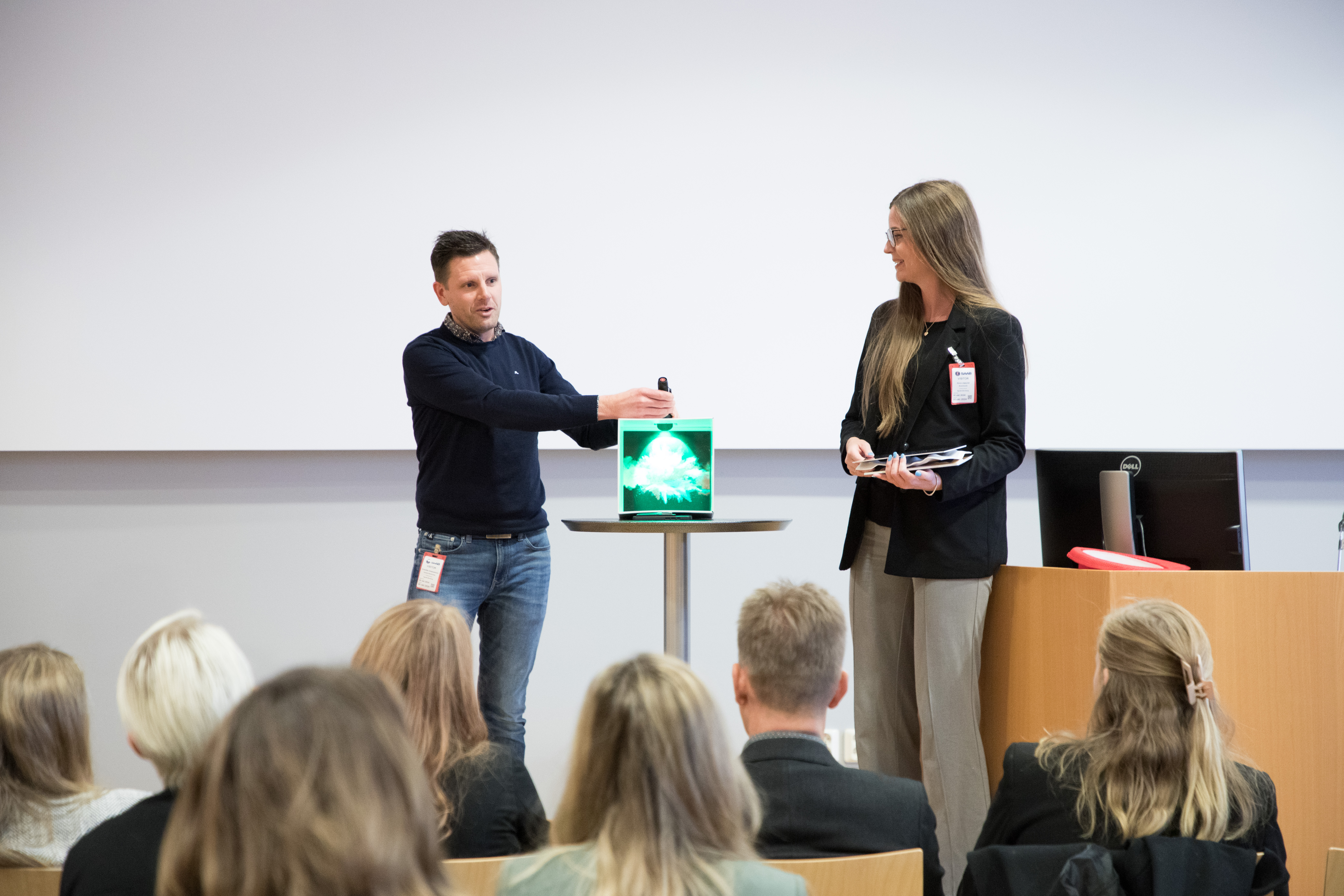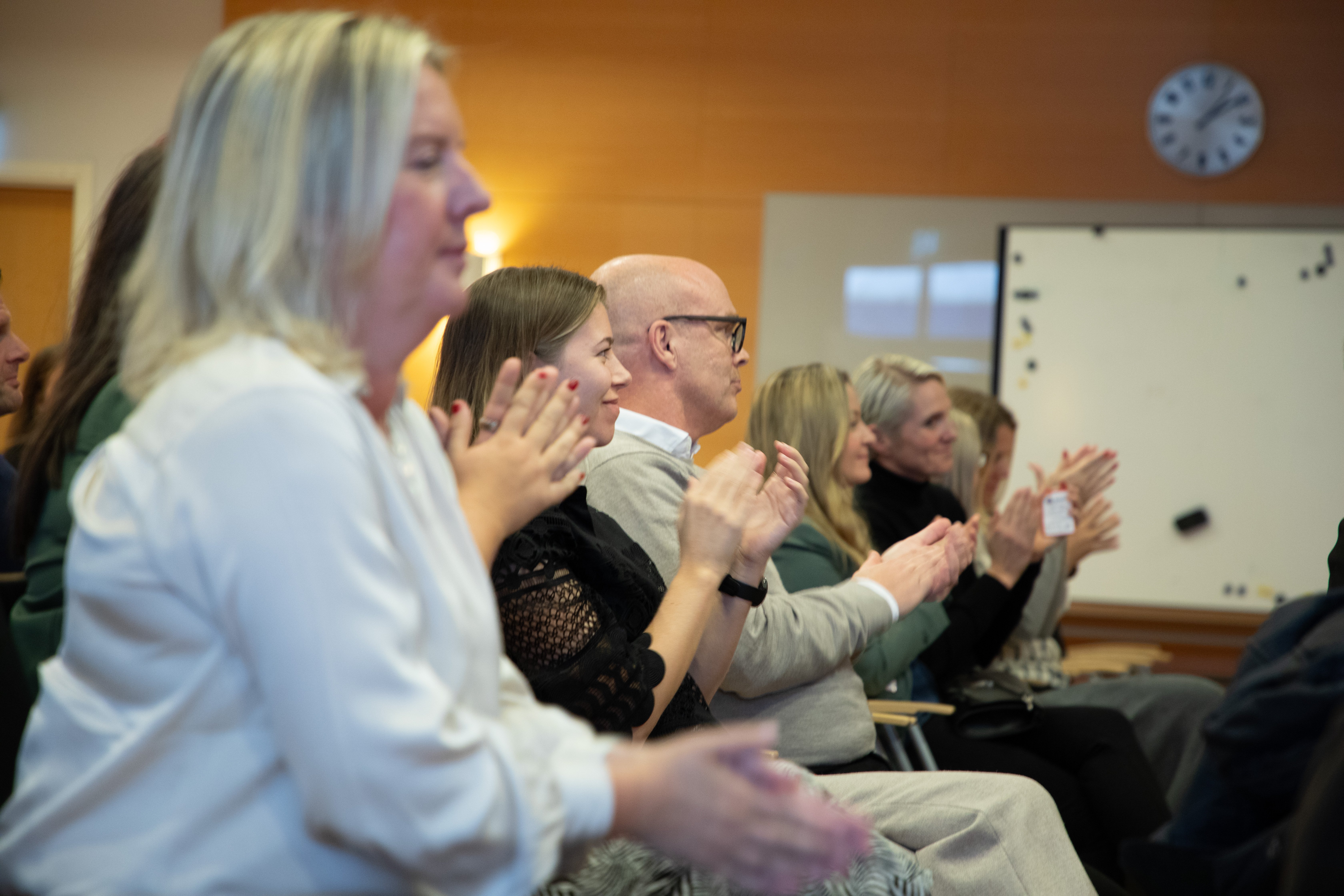
Reversed Mentoring 2024 –“All leadership is about people”
Over the past six months, sixteen leaders from companies around Jönköping have each had a mentor via the Reverse Mentorship program. What makes it »reverse« is that the mentors are younger and at the beginning of their professional careers, while the mentees are more senior. Kristoffer Emanuelsson, production manager at Fagerhult, and Maria Liljeqvist, unit manager within home care in Jönköping municipality, are one of the mentor duos.
Hello Maria and Kristoffer! Reverse Mentoring has come to an end. What have you focused on during your teamwork?
Kristoffer: “We didn’t have any specific goals from the start, but we have reflected and talked a lot, and Maria has come up with input on what I can focus on in my everyday life.”
Maria: “I think we have had a clear theme, where we started from Kristoffer’s thoughts and questions and reflected on them.”

Kristoffer, was there anything you wanted to highlight – and now can take you to your everyday work life?
“I wanted to focus on how I can engage colleagues, and we had several discussions about feedback. It’s easy to get stuck in the classic ‘Good job!’, but instead let a little more developing communication come across, and I want to get better at that towards my colleagues.”
Maria chips in: “I told Kristoffer; you don’t get to say ‘Good job!’ unless you also elaborate on what they did well. It’s so easy to get stuck there.”
Changing old habits and established patterns can be a challenge, how did you like stepping outside the comfort zone?
Kristoffer: “When applying, I decided to give this a real chance. Otherwise, there’s no point! It is important to note that the results largely depend on one’s attitude. That you want to and dare to be a little uncomfortable. We’ve had good discussions and, at the same time, a lot of fun, and that’s vital.”
Maria: “Kristoffer was brave and dared to test the ideas and methods we discussed. It has kept us moving forward.”
Maria, did you learn anything that you take with you – beyond your role as a mentor?
Maria: “Yes, absolutely! Even though we work in very different environments, leadership is always about people, individuals, and how we lead them. That is a valuable insight. Also, we’ve had fun, and Kristoffer strengthened me in my role as a leader. Having a senior leader who listens, embraces and tries my ideas and thoughts about leadership was great.”

You work in widely different industries, have various levels of leadership experience, and are new acquaintances to each other. What are your takeaways from that?
Maria: “We are quite different as individuals, and it was interesting to reflect on that in different scenarios and how it affects leadership. We have learned a lot from each other.”
Kristoffer: “I think it is important to be open about one’s shortcomings, and at the same time embrace new ways of thought. And maybe put any differences about how long you’ve been a leader or age aside – and focus on the conversation. Maria has asked some tougher questions where I felt somewhat uncomfortable, but it has made me question old habits and why I do things a certain way. She has done that very well.”
Kristoffer, from your perspective as a mentee – how do you view Reverse Mentorship?
“Initially, it felt a little uncomfortable, but I recommend taking the chance to apply. Having a mentor was interesting, and reverse mentorship is very rewarding. Reflecting with someone without a connection to my everyday life opens other thoughts and questions. We will stay in touch.”
TEXT LINDA KARLSSON
PHOTO DENNIS BOIJ
Related News

Melanopic lux: lighting for education influenced by human biology
Light is essential in our daily lives, influencing our ability to see, overall well-being and performance. In educational environments, lighting quality can significantly impact students' focus, mood, and energy levels. So, how do we know what is the right amount and quality of light for this setting? Traditionally, light has been measured in lux, a unit of measurement for the intensity of light. It's used to measure how much light falls on a surface or the amount of light in a given space. One lux is the amount of light that falls on a surface that is one square meter in area when one lumen of light is spread out evenly. Recent advancements in research have unveiled the importance of melanopic lux, which goes beyond mere visibility. This measures how effectively light stimulates specific eye cells that regulate crucial non-visual functions such as sleep and alertness. In classrooms and lecture theatres, the melanopic ratio has become vital in lighting design, enabling educators to create spaces that support visual tasks and align with students' biological rhythms. In this article, we explore how lighting solutions can align with our biology, and how this helps to create optimum conditions for educational environments. The science of vision and light The human eye is a remarkable organ designed for high-resolution colour vision within a small area (approximately 2 degrees of the visual field) while relying on peripheral vision for motion detection. This dual-function system, shaped by evolution for survival, continues to influence how we perceive and interact with our surroundings. Our eyes are particularly susceptible to green and yellow light, reflecting our evolutionary adaptation to naturally lit environments. In contrast, blue light, which is chief in modern LED lighting, requires higher intensity to be perceived at the same level. Effective lighting design carefully considers brightness, timing, and distribution to support visual clarity and biological functions like mood and alertness. For example, exposure to bright light in the morning helps regulate circadian rhythms, boosting alertness and mitigating the effects of seasonal darkness. This is particularly important in educational environments, such as schools and universities, where lighting impacts mood, focus, and overall performance. Our Organic Response system provides an innovative solution tailored for these spaces. This smart lighting technology automatically optimises light levels, featuring daylight-responsive sensors and advanced occupancy detection, maintaining a balance between natural and artificial light. Doing so supports visual comfort and reduces energy consumption, making it an ideal choice for creating dynamic, efficient, and student-friendly learning environments. To further support students, well-lit spaces with minimal glare are essential for reducing eye strain and maintaining focus during extended study sessions. Adjusting light intensity and colour temperature for different tasks—such as reading, group discussions, or creative activities—enhances light's visual and non-visual effects. By integrating thoughtful lighting strategies like those offered by Organic Response, educational environments can promote healthier, more productive, and engaging learning experiences. Integrative lighting: Supporting health and well-being. Integrative lighting (also referred to as human-centred lighting) combines visual and non-visual benefits (such as emotional effects) to support biological rhythms and psychological well-being. This approach goes beyond traditional lighting solutions by considering how light impacts circadian rhythms and hormonal balance. Light exposure in the morning is critical for suppressing melatonin (the sleep hormone) and increasing cortisol (the alertness hormone). Proper timing helps align students' natural rhythms with school schedules, which often require a lot of focus. Consistent exposure to bright, cool light early in the day can enhance energy levels and cognitive performance. The melanopic ratio compares the spectral composition of a light source with daylight. Using this information, you can determine its melanopic lighting intensity. This enables the design of lighting setups that precisely meet both visual and biological lighting needs. Lighting recommendations for educational spaces Each learning environment has unique lighting needs. Libraries benefit from direct lighting on the floor, paired with ambient lighting on walls and ceilings. Vertical shelf lighting (200-300 lx) makes it easier to browse titles. Lecture halls, on the other hand, require glare-free, comfortable lighting with flexible control, ideally with pre-programmed scenarios. In auditoriums and classrooms, strong vertical lighting is crucial for clear visual communication, especially over greater distances, enhancing facial expressions and engagement. General lighting recommendations apply to all educational spaces. Our solutions meet industry standards, ensuring reading and writing areas maintain 500 lx for effective visual tasks. Using daylight-responsive sensors for luminaire rows can reduce energy consumption while maximising natural light. The number and arrangement of luminaires should be adjusted based on the room's size and function to ensure consistent illumination. The role of dynamic lighting A Double Dynamic lighting system can be a game-changer in educational environments. It allows for intensity and colour temperature adjustments to match the specific needs of activities, from quiet reading sessions to collaborative group work. Fagerhult's distinct approach to lighting means that our design is human-centric; we integrate scientific insight into light and human psychology, creating environments that support academic performance and well-being. Our focus on energy efficiency also means our advanced control systems optimise light usage while minimising energy consumption, contributing to a building’s sustainability goals. The customisable setting and flexible solutions ensure that educational environments can create tailored lighting profiles for different times of the day or specific learning activities. Long-term benefits of melanopic lighting Melanopic lighting, designed to mimic the natural light spectrum, helps regulate the circadian rhythm, which is essential for maintaining focus, energy, and emotional balance. In classrooms and study areas, proper lighting can reduce eye strain, improve sleep patterns, and enhance mood, which are critical for students' mental health and academic performance. By incorporating lighting that aligns with our biological needs, schools and universities can foster healthier, more productive learning environments,. This is particularly important during the winter months when daylight is limited. Whether through advanced tuneable white light systems, designs that maximise daylight, or energy-efficient solutions, we are dedicated to leading the way in lighting innovation for educational environments, delivering brighter futures—one classroom at a time.
The inspiration behind Nobel Week Lights: ”Light, art and technology intertwined.”
Nobel Week Lights has quickly become a beloved public celebration. During Nobel Week, Stockholm residents flock outdoors to marvel at the spectacular light installations, where contemporary lighting technology meets artistic expression. ”We aim to create a moment of gathering: around light and around something meaningful”, says Lara Szabo Greisman. Nobel Week Lights is a light festival that illuminates Stockholm during the darkest time of the year – a free cultural experience for everyone. Presented by the Nobel Prize Museum, the festival invites international and local artists, designers and students to create light artworks inspired by the Nobel Prize. The installations shed new light on the scientific discoveries, literature and peace efforts of Nobel laureates while offering a fresh perspective on the city. Fagerhult is Principal Partner of Nobel Week Lights 2024, and this year’s edition features 16 different light installations across Stockholm. The artworks can be experienced from 7–15 December, including ”The Wave”, a light installation by the art collective Vertigo, located in front of the Parliament House where visitors can walk right through the luminous wave. The Wave by Vertigo ”Light and art and creativity is incredibly intertwined because these are technologies that are constantly evolving. So part of the fun working with the artists is that they are constantly testing new technologies. And we see these incredible visual results which are based on just pure innovation”, says Lara Szabo Greisman, co-founder and producer of Nobel Week Lights. Lara Lara Szabo Greisman and Leading Lights by Les Ateliers BK The significance of light as a collective force, its ability to encapsulate life and death, joy and sorrow – indeed, the very essence of what it means to be human – makes lighting a powerful medium of artistic expression, she argues: ”The dream for the festival is that this becomes a personal experience for each and every member of the audience. A moment that they remember and cherish . A moment that they think about later and bring forward as their story of connecting with the city.”


